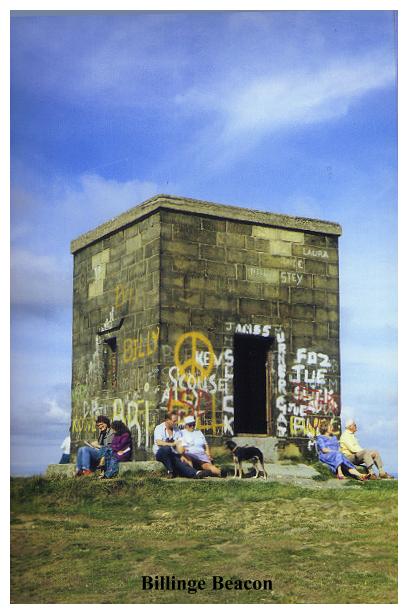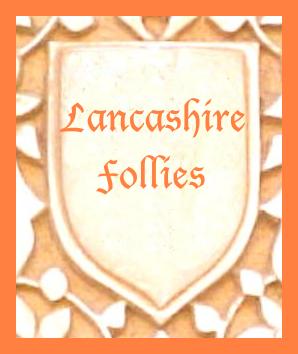9. BILLINGE BEACON
The main attraction of this short and initially unpromising walk are the excellent views over Merseyside to the Welsh mountains. The heavily vandalised Summer House is a fine example of just what should NOT be allowed to happen to our prospect towers and follies.
Getting there: Take the A571 out of Wigan, passing over the M6. The church is at junction of A571 and B5207. Park in recreation ground by public toilets opposite.
Distance: 2 miles. Easy
Map refs: START SD 534 007
BEACON SD 526 015
Rating: Walk * Follies and General Interest *
Billinge is the sort of place you would usually pass through on your way elsewhere. This hilltop village, straggling the road between Wigan and St Helens, has the air of an old community whose fortunes, like the pattern of its development, have gone gradually downhill. Despite a nucleus of old buildings opposite the church, Billinge is essentially a redundant pit village lost in the no-mans-land of the virtually defunct Lancashire coalfield.
Billinge's main feature of interest is its church. The first chapel to serve this hilltop village was constructed in 1534 and was not, it seems, officially consecrated, as there is no trace of any dedication. In 1552 it was visited by the King's Commissioners, who found that the chapel contained little of any value. It was re-furnished, only to be wrecked in the reign of Queen Mary, when the windows were smashed, and the building used as a barn for storing hay. It was not until the eighteenth century that religious interest was rekindled, when James Scarisbricke provided the funds for its reconstruction in 1718. The oak panelling and altar table, along with the fine brass candelabrum date from this period.
Externally the building is oblong with a rounded apse. It has classical Doric columns supporting a long stone roof. The windows contain some fine blue Victorian glass. Beneath the record board there is a brass plate to James Scarisbricke, dated 1721. On the outside parapet are stone urns, and the building has a fine cupola containing a massive bell. The whole picture is one of eighteenth century elegance.
Less elegant is the start of our walk. After an uninspiring stroll through a housing estate, we gradually take to a footpath running around the perimeter of an unsightly (and smelly) landfill site. Beyond, a well worn path winds up to the summit of Billinge Beacon, where a triangulation pillar hides behind an unsightly wall and fence on the very edge of the rubbish-filled chasm.
Behind us is the Summer House which originally belonged to nearby Winstanley Hall. It was also intended as a daymark to shipping. It is a building of gross ugliness - a square concrete floored box completely daubed from top to toe in lurid graffiti. A single doorway gives access to the dark exterior, which smells of human excrement. It seems incredible to think that this was once a building of some elegance. The building originally, we are told, had a pyramid roof, which would have made it very like its neighbour, nearby Ashurst's Beacon. Alas, there is little resemblance to it now.
Yet despite its unpromising appearance, Billinge Beacon is a highly popular local resort. It was thronging with people when we visited it, people talking and picnicking, couples courting, even an artist sitting there pastelling the view. People come here for the view, and there is certainly no faulting that! Billinge Beacon looks mainly to the south-west. Liverpool, with its two cathedrals and highly distinctive skyline, is immediately apparent, and beyond, across the Dee, may be seen the mountains of North Wales. Nearer at hand is the industrial sprawl of nearby St Helens, framed in the Cheshire Hills on the far side of the Mersey, and to the left the great bowl of Greater Manchester clearly seen. Westwards is the coastal plain and the dunes leading up to Southport. Were it not for the adjacent landfill and the noise of juveniles on motorbikes, this would be a most pleasant and peaceful spot.
Beyond the beacon things improve a bit. A newly-erected kissing gate gives access to Billinge Plants, a fine broadleaved wood happily in the possession of the Woodland Trust. This woodland is reminiscent of the type of woods found frequently in the Yorkshire Coalfield - 'bell ground' plantations dotted with the spoil of early mining operations. Here of course, we are in the Lancashire Coalfield so the similarity should not be too surprising.
The rest of the walk is quite pleasant. Arable fields, picturesque cottages and a footpath which quickly becomes a fine promenade along a high level contour offering superb views over Merseyside. I have commented on the unsavoury aspects of this walk, but yet the ugliness is only skin deep. When the tip is full it will be landscaped and grassed over. Even now the Summer House could be restored to a semblance of its former glory, and the hilltop developed into a small country park. If the hordes of local picnickers are anything to go by, the demand is most certainly there. All that is lacking is the will and the money. Here is not only a beautifully sited folly, but also one of the finest viewpoints in Lancashire. Will Billinge Beacon be left to the exclusive attentions of the vandals bikers? We must hope not!









